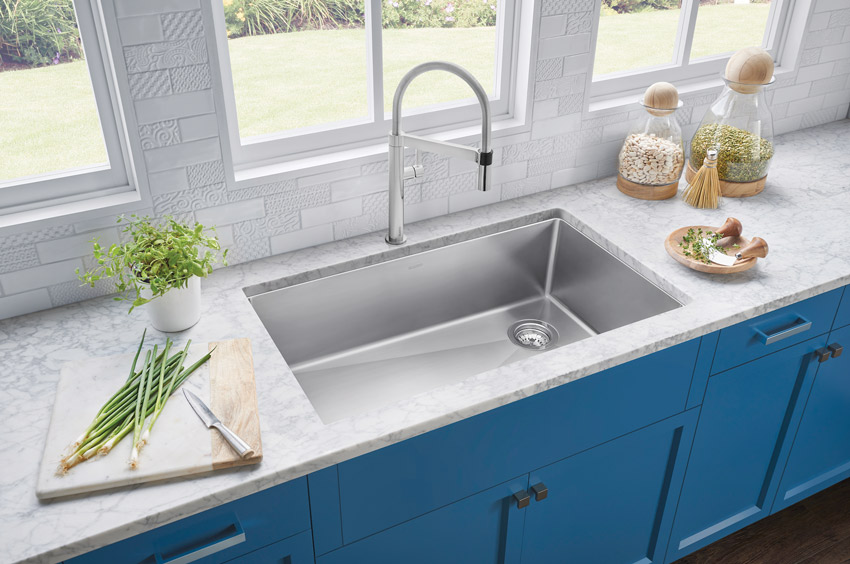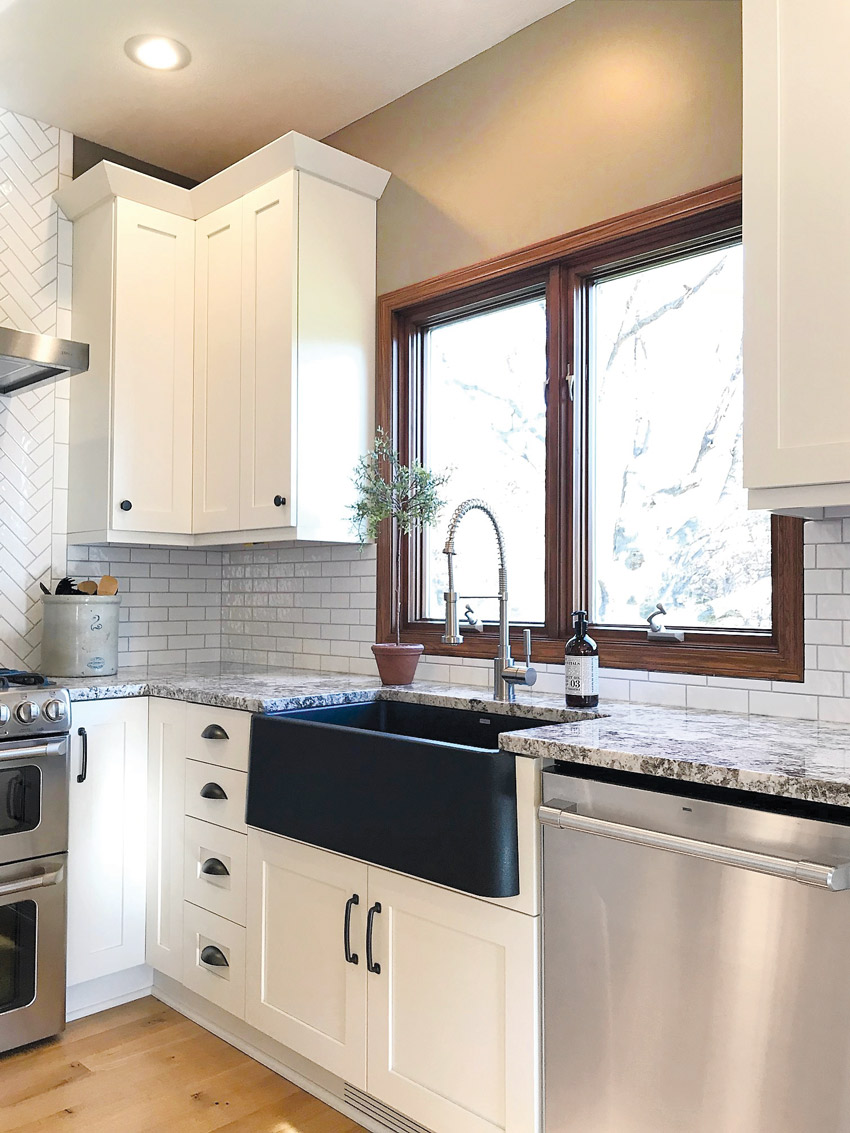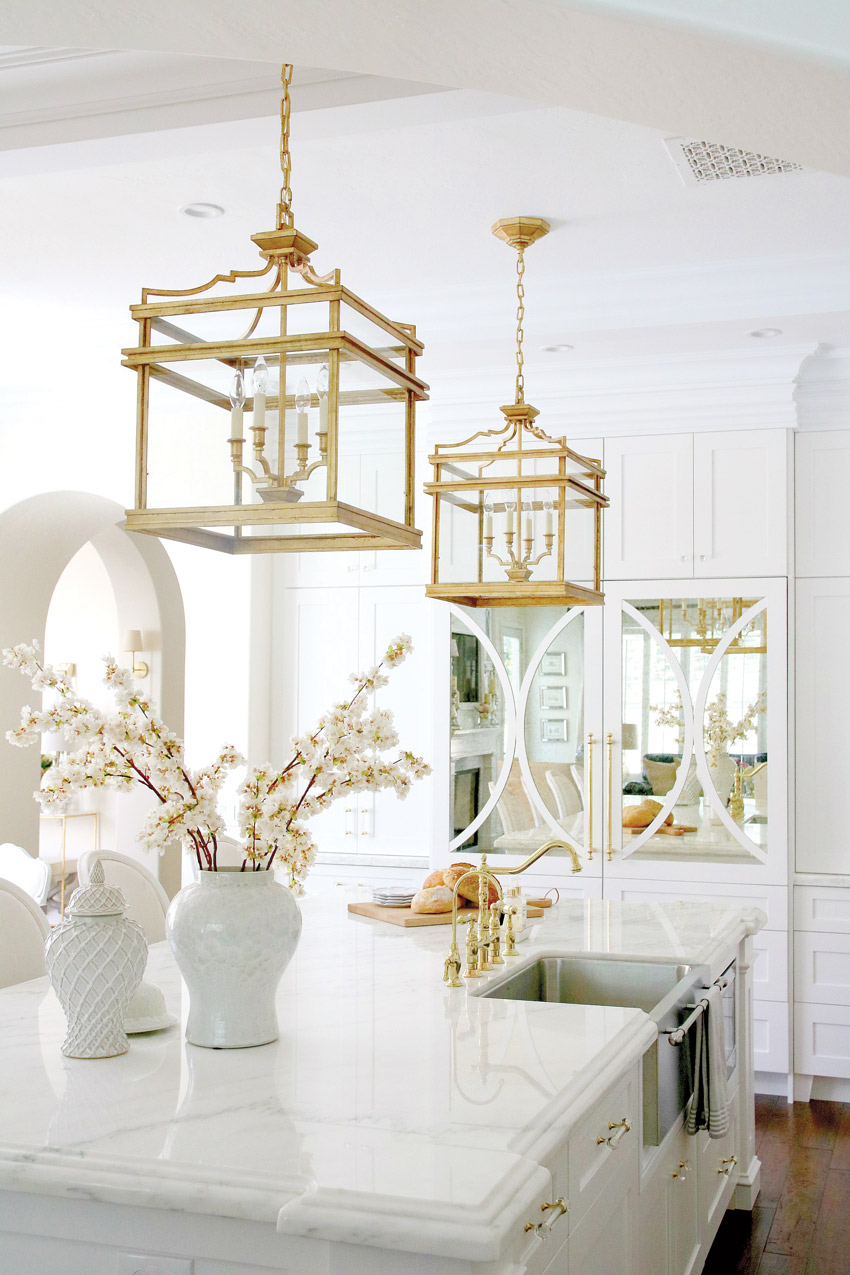Mastering the Art of the Kitchen Sink
The Materials of the Art
When selecting a kitchen sink, its attributes will impact its ergonomics and functionality. First and foremost, a sink’s material dictates its cost, functionality, and lifespan. Secondarily, a sink’s material helps to support and enhance a kitchen’s design and aesthetic.
Regardless of material, there are several key parameters that designate a quality sink. The best kitchen sink design will have an equal measurement at the top and bottom to make the most of every inch. Sinks with smaller bottom measurements reduce usable space. The design should direct water straight toward the drain. Quality sinks are crafted with smooth, easy-to-clean corners, either perfectly square or slightly rounded, with no weld lines to ease cleaning and keep the bowl hygienic. All finishes must be even since uneven finishes invite bacterial growth in flaws. While aesthetics are typically linked first to material, the sink’s material has a major effect on how healthy and usable the sink will be. Different materials require different maintenance strategies and can create hygienic benefits.
Stainless Steel
The most popular material for kitchen sinks today remains stainless steel. Because of its flexibility as a material, stainless steel sinks are available in a wide variety of sizes, styles, and types. Stainless steel is heat, stain, and chip resistant.
Stainless steel is classified in terms of gauge. A lower gauge number means slightly thicker steel was used in the sink’s construction, while a higher gauge number means thinner steel was used. Most sinks fall within the 16- to 24-gauge range, with the majority of residential sinks falling between 18 and 22 gauge. However it is important to note that the actual difference between gauges is small. For example, the difference in thickness between a 16-gauge and 18-gauge sink is only 1/16 inch.
To add an extra aesthetic to the stainless steel, manufacturers may offer different finishes, from satin to glossy.
A superior stainless steel sink is made of 304 series alloy stainless steel, featuring the highest-quality 18/10 chrome-nickel formulation. This nonporous material provides a hygienic, rust-free, and extremely durable product. Certain manufacturer finishes, such as a satin polished finish, help to create an enduring, easy-to-clean luster that is impervious to water stains and calcium deposits.
Stainless steel sinks do have several drawbacks. As a material, stainless steel easily conveys noise, so sound-deadening pads or a spray coating should be incorporated to reduce sink noise from running water and the garbage disposal. Stainless steel can also scratch more easily than other sink materials and is liable to show water spots. Cheap stainless steel sinks with uneven finishes can quickly discolor and may allow bacteria to grow in finish flaws.
While prices are dependent on the gauge of the steel, its size, and its mounting type, stainless steel offers an affordable and durable material choice for the kitchen sink.

Stainless steel sinks remain the most popular material choice for kitchens today. Certain manufacturer finishes, such as a satin polished finish, help to create an enduring, easy-to-clean luster that is impervious to water stains and calcium deposits.
Cast Iron
One of the oldest materials used for sinks, cast iron remains a popular design choice. To manufacture the sink, a glossy porcelain enamel finish is fused over a cast iron base. Because the outer finish is an enamel, cast iron sinks come in a range of colors that offer good resistance to fading. The durable, glossy enamel also resists stains and scratching.
Cast iron sinks do have several drawbacks; principle among these are their weight. Cast iron sinks can easily weight in at more than 100 pounds, up to three times more than a stainless steel sink, meaning difficulty in installation and the requirement of additional supports for certain installation methods. The weight of cast iron also impacts cabinet choices; selected cabinets must be structurally sound to provide adequate support for the sink over time. Additionally, if the sink’s enamel coating does chip, the cast iron beneath is highly susceptible to rust, necessitating repair.
Cast iron also is more expensive than stainless steel, with designer color selections carrying a premium price tag.

Farmhouse-style sinks lend a rustic aesthetic and are a popular trend for kitchen design.
Composite Sinks
An emerging sink material over the past decade, composite sinks are usually made from either a granite or quartz composite. The crushed stone is mixed with a resin filler, in an average ratio of 80 percent stone to 20 percent resin. This combination produces a material that shares aesthetic qualities with real granite or quartz without the maintenance and durability issues associated with solid stone sinks. It also allows for a range of color options, depending on the manufacturer. The variable color palette gives it the ability to pair well with a variety of natural stone and granite countertops.
Composite sinks are tough and highly resistant to stains and scratching, but, as a general rule, granite composites have a higher durability than quartz. The leading granite composite sinks also boast heat resistance up to 536 degrees Fahrenheit, exceptional cleanability with hydrophobic finishes, and resistance to household acids and alkali solutions.
Entry-level composite sinks have a price point comparable to cast iron and can increase in price from there, depending on composite material and color.
Fireclay
Fireclay sinks are manufactured by molding ceramic clay into the desired shape, allowing the clay to dry, and then applying porcelain enamel at extremely high temperatures. This process effectively fuses enamel to the clay, helping to enhance the sink’s strength. Because the clay base determines the shape, fireclay sinks are available in a wide variety of sizes and shapes and can suit any installation method. Fireclay sinks are highly resistant to scratches, staining, and chipping and are easy to clean. Fireclay sinks are most commonly associated with farmhouse or apron-style sinks. Both the shape and material bring a rustic countryside aesthetic to any classic or contemporary kitchen design.
However, fireclay can be more prone to chipping than other sink materials, requiring proper installation and care to minimize this risk. The enamel coating can also chip under impact from dropped pots and pans.
Fireclay kitchen sinks do command a price premium, and tend to be one of the more expensive material options.
Copper
As a material, copper offers durability as well as being naturally rust resistant and antimicrobial. The copper surface may be hammered for a rustic aesthetic, and the material develops a patina as it ages.
Careful selection is a must when considering a copper sink. A quality copper sink is at least 99 percent pure copper. A small amount of zinc, added for strength, is allowable. The sink should also be properly sealed by the manufacturer and maintained according to manufacturer instructions. No harsh chemicals may be used on copper, as it will destroy the finish.
Copper sinks command a price premium, making them one of the more expensive sink materials.
Alternative Materials
- Natural Stone: Designers are experimenting with natural stone sinks to match or complement natural stone countertops in kitchens. While some materials, like soapstone, resist stains well, many natural stone sinks easily stain and will need proper maintenance and sealing to remain hygienic.
- Glass: Tempered or safety glass offers a strong and striking sink material, particularly for contemporary design. However, contact with heavy objects can cause scratches or chips, and the glass surface clearly shows water and soap spots.
- Fiberglass: Fiberglass-reinforced plastic can be molded into a variety of shapes and sizes, and is inexpensive, strong, and lightweight. However, these sinks have a short lifespan, are not as durable, and do not maintain their surface finish as well as other materials.

The kitchen sink at the Garrett Residence reflects the overall aesthetic of the home, marrying modern materials with rustic design.









